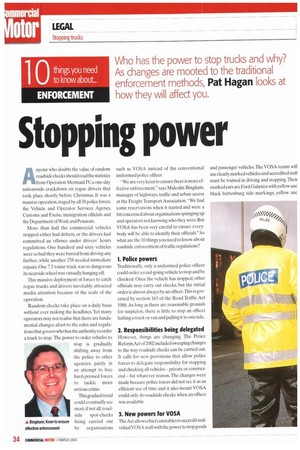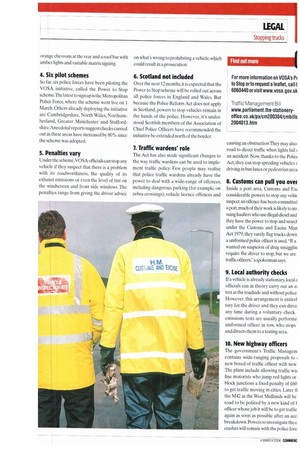Stopping power
Page 34

Page 35

If you've noticed an error in this article please click here to report it so we can fix it.
Anyone who doubts the value of random roadside checks should read the statistics from Operation Mermaid IV, a one-day nationwide crackdown on rogue drivers that took place shortly before Christmas. It was a massive operation, staged by all 38 police forces. the Vehicle and Operator Services Agency, Customs and Excise, immigration officials and the Department of Work and Pensions.
More than half the commercial vehicles stopped either had defects, or the drivers had committed an offence under drivers' hours regulations. One hundred and sixty vehicles were so bad they were barred from driving any further, while another 258 needed immediate repairs. One 7.5 tonne truck was so dangerous its nearside wheel was virtually hanging off.
This massive deployment of forces to catch rogue trucks and drivers inevitably attracted media attention because of the scale of the operation.
Random checks take place on a daily basis without ever making the headlines. Yet many operators may not realise that there are fundamental changes afoot to the rules and regulations that govern who has the authority to order a truck to stop. The power to order vehicles to stop is gradually shifting away from the police to other agencies, partly in an attempt to free hard-pressed forces to tackle more serious crime.
This gradual trend could eventually see most. if not all, road side spot-checks being carried out by organisations such as VOSA instead of the conventional uniformed police officer.
"We are very keen to ensure there is more effective enforcement," says Malcolm Bingham, manager of highways, traffic and urban access at the Freight Thansport Association. "We had some reservations when it started and were a bit concerned about organisations springing up and operators not knowing who they were. But VOSA has been very careful to ensure everybody will be able to identify their officials." So what are the 10 things you need to know about roadside enforcement of traffic regulations?
1. Police powers Traditionally, only a uniformed police officer could order a road-going vehicle to stop and be checked. Once the vehicle has stopped, other officials may carry out checks. but the initial order is almost always by an officer. This is governed by section 163 of the Road Traffic Act 1988. As long as there are reasonable grounds for suspicion, there is little to stop an officer halting a truck or van and pulling it to one side.
2. Responsibilities being delegated However, things are changing. The Police RefonnAct of 2002 included sweeping changes to the way roadside checks can be carried out. It calls for new provisions that allow police forces to delegate responsibility for stopping and checking all vehicles —private or commercial — for whatever reason. The changes were made because police forces did not see it as an efficient use of time and it also meant VOSA could only do roadside checks when an officer was available.
3. New powers for VOSA "Ibe Act allows chief constables to accredit individual VOSA staff with the power to stop goods and passenger vehicles. The VOSA teams will use clearly marked vehicles and accredited staff must be trained in driving and stopping. Theii marked cars are Ford Galaxies with yellow and black battenburg side markings. yellow and orange chevrons at the rear and a roof bar with amber lights and variable matrix signing.
4. Six pilot schemes
So far, six police forces have been piloting the VOSA initiative, called the Power to Stop scheme.The latest to sign up is the Metropolitan Police Force, where the scheme went live on 1 March. Others already deploying the initiative are Cambridgeshire, North Wales, Northumberland, Greater Manchester and Staffordshire. Anecdotal reports suggest checks carried out in these areas have increased by 80% since the scheme was adopted.
5. Penalties vary
Under the scheme, VOSA officials can stop any vehicle if they suspect that there is a problem with its roadworthiness, the quality of its exhaust emissions or even the level of tint on the windscreen and front side windows. The penalties range from giving the driver advice on what's wrong to prohibiting a vehicle, which could result in a prosecution.
6. Scotland not included
Over the next 12 months, it is expected that the Power to Stop scheme will be rolled out across all police forces in England and Wales. But because the Police Reform Act does not apply in Scotland, powers to stop vehicles remain in the hands of the police. However, it's understood Scottish members of the Association of Chief Police Officers have recommended the initiative be extended north of the border.
7. Traffic wardens' role
The Act has also made significant changes to the way traffic wardens can he used to implement traffic policy. Few people may realise that police traffic wardens already have the power to deal with a wide-range of offences, including dangerous parking (for example, on zebra crossings), vehicle licence offences and causing an obstruction They may also road to direct traffic when lights fail an accident. Now, thanks to the Polict Act, they can stop speeding vehicles E driving in bus lanes or pedestrian area 8. Customs can pull you over Inside a port area. Customs and ExI considerable powers to stop any vehic suspect an offence has been committed a port, much of their work is likely to ins suing hauliers who use illegal diesel and they have the power to stop and searct under the Customs and Excise Man Act 1979, they rarely flag trucks down a uniformed police officer is used. "If a wanted on suspicion of drug smugglin require the driver to stop, but we are traffic officers," a spokesman says 9. Local authority checks
If a vehicle is already stationary. local a officials can in theory carry out an ei test at the roadside and without police However, this arrangement is entirel tary for the driver and they can drive any time during a voluntary check. emissions tests are usually performe uniformed officer in tow, who stops and directs them to a testing area.
10. New highway officers The government's Traffic Managem contains wide-ranging proposals to new breed of traffic officer with new The plans include allowing traffic wai fine motorists who jump red lights or block junctions a fixed penalty of £60 to get traffic moving in cities. Later (I the M42 in the West Midlands will be road to be policed by a new kind of t officer whose job it will be to get traffic again as soon as possible after an acci breakdown. Powers to investigate the c crashes will remain with the police fort


































































































































































































